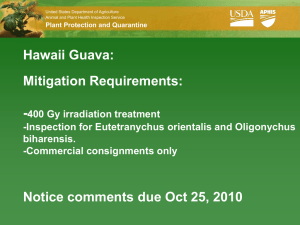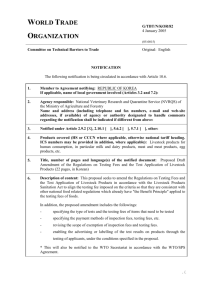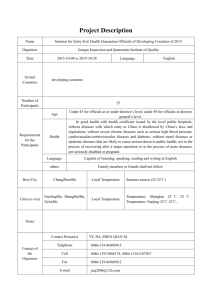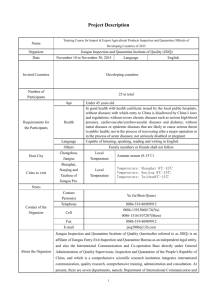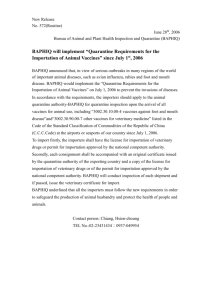Powerpoint - Southeast Exotic Pest Plant Council
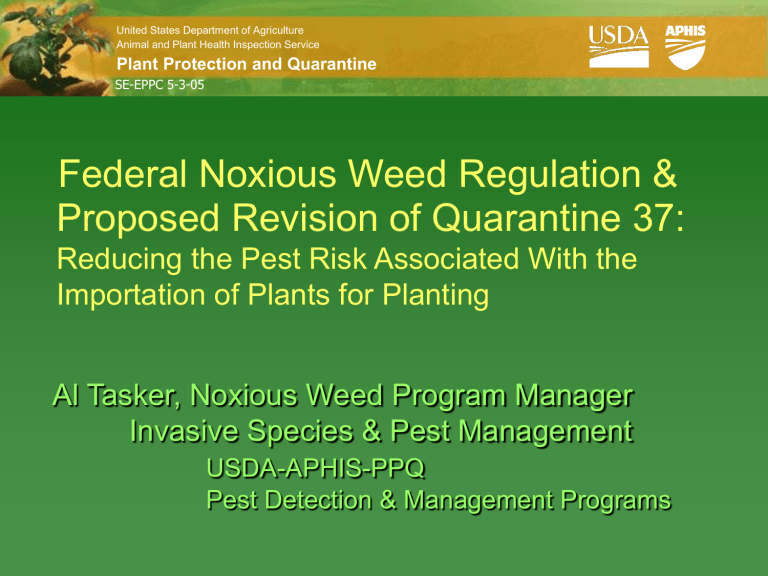
United States Department of Agriculture
Animal and Plant Health Inspection Service
Plant Protection and Quarantine
SE-EPPC 5-3-05
Federal Noxious Weed Regulation &
Proposed Revision of Quarantine 37:
Reducing the Pest Risk Associated With the
Importation of Plants for Planting
Al Tasker, Noxious Weed Program Manager
Invasive Species & Pest Management
USDA-APHIS-PPQ
Pest Detection & Management Programs
United States Department of Agriculture
Animal and Plant Health Inspection Service
Plant Protection and Quarantine
SE-EPPC 5-3-05
What is a rule and when must APHIS conduct rulemaking?
• Under U.S. law, a rule is any requirement of general applicability and future effect
• An agency may issue rules only within the scope of its authorizing legislation
• APHIS must conduct rulemaking whenever it wishes to enforce a rule
United States Department of Agriculture
Animal and Plant Health Inspection Service
Plant Protection and Quarantine
SE-EPPC 5-3-05
What is the rulemaking process?
• The principal requirements for rulemaking are set by the Administrative Procedure Act (APA)
(5 U.S.C. 551 et seq.)
• Agencies can enforce rules that are properly issued. Rules that are not properly issued may be successfully challenged in court
(arbitrary and capricious)
United States Department of Agriculture
Animal and Plant Health Inspection Service
Plant Protection and Quarantine
SE-EPPC 5-3-05
Levels of publication
• Advanced Notice of Proposed Rulemaking
(ANPR)
• Proposed Rule
• Interim Rule
• Final Rule
United States Department of Agriculture
Animal and Plant Health Inspection Service
Plant Protection and Quarantine
SE-EPPC 5-3-05
Need Identified
Risk analysis prepared if necessary
Proposed rule reviewed by USDA attorneys and policy officials, plus OMB if “significant” or
“economically significant”
Work plan prepared, reviewed, and designated
“not significant,”
“significant,” or
“economically significant” by the Office of
Management and Budget
(OMB)
Proposed rule published in the
Federal Register with 60-day comment period
If an interim rule, effective prior to start of comment period
Proposed rule drafted; all required analyses completed
Comments arrive;
Public hearings may be held
United States Department of Agriculture
Animal and Plant Health Inspection Service
Plant Protection and Quarantine
SE-EPPC 5-3-05
Issues raised by commenters are considered; decisions made about how to proceed
Final rule reviewed by USDA attorneys and policy officials, plus OMB if “significant” or
“economically significant”
New work plan for final rule prepared, reviewed, and designated
Final rule published in the Federal Register
Final rule drafted
Final rule effective, usually
30 days after publication
United States Department of Agriculture
Animal and Plant Health Inspection Service
Plant Protection and Quarantine
SE-EPPC 5-3-05
Not significant:
This term has nothing to do with an action’s importance or priority; it simply means that OMB has decided not to review the docket.
United States Department of Agriculture
Animal and Plant Health Inspection Service
Plant Protection and Quarantine
SE-EPPC 5-3-05
Significant: An action that is likely to:
Have an annual effect on the economy of $100 million or more or adversely affect in a material way the economy, a section of the economy, productivity, competition, jobs, the environment, public health or safety, or State, local, or tribal governments or communities;
Create a serious inconsistency or otherwise interfere with an action taken or planned by another agency;
Materially alter the budgetary impact of entitlements, grants, user fees, or loan programs or the rights and obligations of recipients thereof; or
Raise novel legal or policy issues arising out of legal mandates, the
President’s priorities, or the principles set forth in Executive Order 12866.
United States Department of Agriculture
Animal and Plant Health Inspection Service
Plant Protection and Quarantine
SE-EPPC 5-3-05
Economically significant:
•
An action likely to result in the effects listed in (1) on previous slide:
– Have an annual effect on the economy of $100 million or more or adversely affect in a material way the economy, a section of the economy, productivity, competition, jobs, the environment, public health or safety, or State, local, or tribal governments or communities;
United States Department of Agriculture
Animal and Plant Health Inspection Service
Plant Protection and Quarantine
SE-EPPC 5-3-05
“Not significant” rules: “ Significant” or “economically significant” rules:
USDA Clearances:
USDA Clearances:
1.
Office of General Counsel
2.
Deputy Administrator
3.
Administrator
4.
Office of Budget and Program
Analysis
5.
Under Secretary, Marketing and
Regulatory Programs
1. Office of General Counsel
2. Deputy Administrator
3. Administrator
4. The General Counsel for USDA
5. Office of Budget and Program
Analysis
6. Office of the Chief Economist
7. *Office of Risk Assessment and
Cost-Benefit Analysis
8. Assistant Secretary for Administration
9. Office of the Chief of Information
10. Under Secretary, Marketing and
Regulatory Programs
11. Secretary
12. Office of Management & Budget
* For economically significant rules only
United States Department of Agriculture
Animal and Plant Health Inspection Service
Plant Protection and Quarantine
SE-EPPC 5-3-05
Typical Time Required for Rulemaking
Work Plan Proposal Comment Period Final Rule Effective Date
“Not significant” rule:
1 year
“Significant” or
“economically significant” rule:
2-3 years
Some take a little less time; some take longer.
United States Department of Agriculture
Animal and Plant Health Inspection Service
Plant Protection and Quarantine
SE-EPPC 5-3-05
Other Acts & Reviews
• Executive Order 12866 of Sept. 30, 1993, “Regulatory
Planning and Review”
• The Regulatory Flexibility Act (5 U.S.C. 601 et seq.)
• The National Environmental Policy Act (42 U.S.C. 4321 et seq.)
• Section 7 of the Endangered Species Act (16 U.S.C. 1536)
• The Congressional Review Act of 1996 (5 U.S.C. 801 et seq.)
• The Paperwork Reduction Act of 1995 (44 U.S.C. 3501 et seq.)
United States Department of Agriculture
Animal and Plant Health Inspection Service
Plant Protection and Quarantine
SE-EPPC 5-3-05
The World Trade Organization Agreement on the Application of Sanitary and Phytosanitary
Measures
• Principles of:
– Transparency
– Harmonization
– Equivalence
– Risk assessment
– Regionalization
United States Department of Agriculture
Animal and Plant Health Inspection Service
Plant Protection and Quarantine
SE-EPPC 5-3-05
Q-37 Revision
United States Department of Agriculture
Animal and Plant Health Inspection Service
Plant Protection and Quarantine
SE-EPPC 5-3-05
Plants for Planting (Q-37)
• Code of Federal Regulations (CFR), 7 CFR Part 319.37
(Q-37)
• The principal regulation governing the import of plants for planting
• Other related regulations also covered in the revision (all 7
CFR)
• 319.15 Sugarcane
• 319.19 Citrus & related genera
• 319.24 & .41 Corn & related genera
• 319.55 Rice
• 319.59 Wheat
• 319.8 Cotton
United States Department of Agriculture
Animal and Plant Health Inspection Service
Plant Protection and Quarantine
SE-EPPC 5-3-05
Why Does Importation of Plants for
Planting Present Significant Risks
• Difficult to determine origin
• Difficult to inspect at ports of entry
• Many pests borne internally ( e.g., diseases, small invertebrates)
• Introduced pests relatively likely to become established
• Production facilities moving off shore to remain competitive
– examples: geranium, tropical foliage, poinsettia
• Inadequate information on pests that may have quarantine significance
United States Department of Agriculture
Animal and Plant Health Inspection Service
Plant Protection and Quarantine
SE-EPPC 5-3-05
Pests That Have Entered, (or May Have
Entered) With Plants for Planting
• Citrus Canker
• Day lily rust
• Dogwood anthracnose
• Eucalyptus pitch canker
• Phytophthora ramorum
(Sudden oak death)
• Plum pox potyvirus
• Ralstonia solanacearum race 3, biovar 2
• Emerald ash borer
• Hemlock wooly adelgid
• Karnal bunt
• Longhorn beetles, cedar, citrus, Asian
• Pink hibiscus mealybug
• Red gum lerp psyllid
• Corn cyst nematode
• Devil’s tearthumb
• Japanese knotweed
• Tropical Soda apple
United States Department of Agriculture
Animal and Plant Health Inspection Service
Plant Protection and Quarantine
SE-EPPC 5-3-05
Basic Premise of Current Q-37
• Majority of plant taxa are enterable with only a port of entry inspection
• Some plants for planting are further restricted by additional requirements
• Pest risk analysis required only for certain types of importations
United States Department of Agriculture
Animal and Plant Health Inspection Service
Plant Protection and Quarantine
SE-EPPC 5-3-05
Evolution of Q-37:
Original Intent
vs
Current Practice
Early Years Now
Trading
Partners
# of Items
Allowed Import
Fumigation
Europe
Limited (< 100 items) germplasm of clonal material only
Worldwide
Unlimited
Likely Purpose of Importation
Mandatory on all Imported Stock Only When Quarantine
Pest Found
Nursery propagation program
“starter” material
Slow distribution
Direct field/homeowner planting
Immediate distribution
United States Department of Agriculture
Animal and Plant Health Inspection Service
Plant Protection and Quarantine
SE-EPPC 5-3-05
Revision of Q-37 Involves Multiple
Phases / Activities / Challenges
• Operational:
– Will affect mostly PPQ, but also DHS-CBP
• Regulatory:
– Multiple regulatory changes will be needed
– Goal… minimize impact on trade while maximizing reduction in pest risk
• Stakeholder:
– Some new requirements
– Greater protection of assets
United States Department of Agriculture
Animal and Plant Health Inspection Service
Plant Protection and Quarantine
SE-EPPC 5-3-05
Advance Notice of Proposed
Rulemaking (ANPR)
• Published Dec 10, 2004
• “Nursery Stock Regulations”, Docket No. 03-069-1
• Comment Period Open Until March 10, 2005
(extended until April)
• View ANPR and comments at: http://www.aphis.usda.gov/ppq/weeds/nursery/
United States Department of Agriculture
Animal and Plant Health Inspection Service
Plant Protection and Quarantine
SE-EPPC 5-3-05
Revising Q-37:
Highlights of the 2004 ANPR
1. Programs to reduce risk of entry and establishment of plant pests
2. Establish a new import entry category
3. Improve data collection to determine taxa imported, origin, and volume
4. Reevaluate taxa currently prohibited
5. Incorporate all plants for planting into one regulation
United States Department of Agriculture
Animal and Plant Health Inspection Service
Plant Protection and Quarantine
SE-EPPC 5-3-05
1. Programs to reduce risk of entry and establishment: Clean Stock Program
Elements of an Accredited/Certified Clean Stock Program:
• Clean stock produced by foreign exporters
• Best practices for importers
• Incentive for grower participation
• NAPPO set standard, provide review, approval and oversight
• Accredited grower pest management program ( e.g
., best practices, ISO)
– including pest free propagation material
• US review and approval
• NAPPO and US monitor and audit production and shipments
• Penalties and remedial action for non-compliance
United States Department of Agriculture
Animal and Plant Health Inspection Service
Plant Protection and Quarantine
SE-EPPC 5-3-05
2. Establish a new import entry category
Plant taxa would be “Excluded pending risk evaluation and approval” (Q-56 model)
• Two approaches possible
– All taxa that have not already entered the US
– Only for taxa where reasonable indication of pathway for invasive pest or is invasive pest
• Criteria science-based but less stringent than
PRA
United States Department of Agriculture
Animal and Plant Health Inspection Service
Plant Protection and Quarantine
SE-EPPC 5-3-05
3. Improve data collection to determine taxa imported, origin, and volume
• No one source for data
• Ongoing analysis
• Support regulation change, grandfathering taxa
United States Department of Agriculture
Animal and Plant Health Inspection Service
Plant Protection and Quarantine
SE-EPPC 5-3-05
4. Reevaluate taxa currently prohibited
• Not just Q-37, also Q-19, 41, 55, etc.
• Consider pests associated with plant taxon
• Need PRA to determine all pests of concern
United States Department of Agriculture
Animal and Plant Health Inspection Service
Plant Protection and Quarantine
SE-EPPC 5-3-05
5. Incorporate All Plants for Planting
Into One Regulation
• Promote clarity, consistency, and transparency
• Possibly include Noxious weeds and other regulated taxa
( e.g., CITES)
United States Department of Agriculture
Animal and Plant Health Inspection Service
Plant Protection and Quarantine
SE-EPPC 5-3-05
“Departmental” Permits
• For prohibited articles
• Original intention… research, by USDA
• Current usage… various, insufficient oversight
• Strategy for improvement:
– Phase 1 (now): More appropriate conditions, and more involvement of State Officials
– Phase 2: Modify name to “Research”, expand beyond USDA
• Proposed Rule (draft) to modify existing regulations
– Phase 3: Create new classes of permits (intended use)
• Example, commercial development
United States Department of Agriculture
Animal and Plant Health Inspection Service
Plant Protection and Quarantine
SE-EPPC 5-3-05
Time Frames
Comment Period Closes, ANPR: March 10, 2005
(extended to April)
Begin March, 2005 Analyze ANPR Comments
Proposed Rule, Departmental (Research) Permit 2005
Import of Christmas and Easter Cactus IGM from the Netherlands and Denmark (Proposed Rule)
2005
Proposed Rule, Standards for Including Species on
“Exclude Pending PRA List”
Early 2006
Continuing work with NAPPO and globally on development of standards for clean stock programs
2005
United States Department of Agriculture
Animal and Plant Health Inspection Service
Plant Protection and Quarantine
SE-EPPC 5-3-05
ANPR
• APHIS is currently in the process of summarizing and evaluating the comments received.
• Public comments range
– from opposition to regulatory changes because of possible impacts on gardening and small businesses (such as nurseries) to
– unequivocal support for more stringent regulations.
• A public hearing will be held in Riverdale, MD May 25,
2005 to discuss the proposed new exclusion category, and criteria for including and removing taxa from the category.
United States Department of Agriculture
Animal and Plant Health Inspection Service
Plant Protection and Quarantine
SE-EPPC 5-3-05
APHIS Noxious Weed Program Manager
Alan.V.Tasker@usda.gov
301/734-5708 www.aphis.usda.gov/ppq/weeds
United States Department of Agriculture
Animal and Plant Health Inspection Service
Plant Protection and Quarantine
SE-EPPC 5-3-05
Noxious Weed Control and Eradication Act of 2004 (WCEA)
(S144/H.R.119) adopted as
P.L. 108-412 10/10/2004 (7 USC 7781-86)
Al Tasker, Noxious Weed Program Manager
Invasive Species & Pest Management
USDA-APHIS-PPQ
Pest Detection & Management Programs
Biological Control Technical Advisory Group Meeting April 2005
United States Department of Agriculture
Animal and Plant Health Inspection Service
Plant Protection and Quarantine
SE-EPPC 5-3-05
• Plant Protection Act (7 U.S.C. 7701 et seq.) is amended
• Under authority of Secretary of Agriculture
United States Department of Agriculture
Animal and Plant Health Inspection Service
Plant Protection and Quarantine
SE-EPPC 5-3-05
Implementation
• Delegation details are in progress 4-7-05 submitted to Office of General Council)
• Interim planning for implementation is in progress in case funding becomes available before full plan is finished
• Request for Proposals (RFP) is in draft
• Planning is beginning for:
– Staffing
– Operations including grant application process
– Grant/Agreement Management
– Target setting
United States Department of Agriculture
Animal and Plant Health Inspection Service
Plant Protection and Quarantine
SE-EPPC 5-3-05
Summary
• Implementation details under development
• Total in bill authorized per year as $7.5 million for matching grants, $7.5 million for agreements
• Authorized for years 2005 to 2009
• Under authority of Secretary of Agriculture (PPA activities are delegated to APHIS)
• While authorized for years 2005 to 2009, no appropriated funds are currently available
United States Department of Agriculture
Animal and Plant Health Inspection Service
Plant Protection and Quarantine
SE-EPPC 5-3-05
Permits, Registrations & Imports (PRI) Structure
PRI Director’s Office
Permit
Services
-Issues all types of PPQ permits
-Administrative functions for permits and select agent registration
Pest Permit
Evaluation
-Scientific review, risk analysis, issuance of pest permits
-Select Agent registration
-Scientific support
Commodity
Import Analysis and Operations
-Import Policy
-Q-37 Revision and Policy
-Risk
Management
